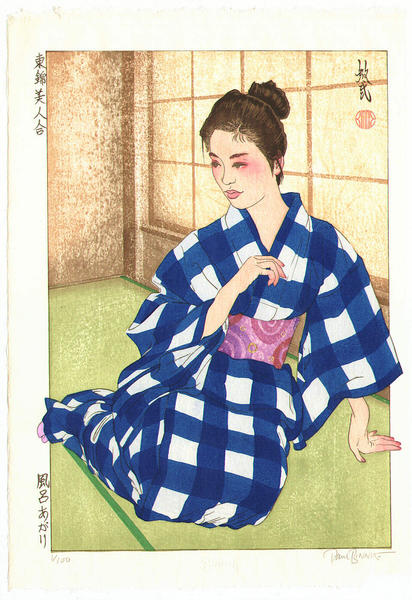| | |
| Artist: | Binnie Paul (1967- ) |
| Title: | After a Bath |
| Series: | Collection of Eastern Brocade Beauties |
| Date of first edition?: | Not set |
| Publisher (first edition)?: | Self |
| Publisher (this edition)?: | Self |
| Medium (first edition): | Woodblock |
| Medium (this edition): | Woodblock |
| Format (first edition): | Not Set
|
| Format (this edition): | Not Set |
| DB artwork code: | 39982 |
| Notes (first edition)?: |
|
| Notes (this edition)?: |
| The following information was taken from the original web listing of this artwork. Note that there may be some inaccuracies:
Tuesday, 2 January 2007
Title After Bath - Collection of Eastern Brocade Beauties
limited edition : 1 / 100
Artist Paul Binnie born 1967 Biography Resume
Signature Signed and numbered by artist in pencil on lower margin
Seal Artist's seal
Dated 2006
Publisher Published by the artist
Medium/Technique Woodblock print
Impression Printed on a handmade, Japanese paper
Colors excellent … gold colored metallic pigment
Condition excellent - very good
Edition Size 100
Numbered 1 / 100
Description "Furo Agari" (After Bath). This is the second print in a new series of Japanese women called 'To Nishiki Bijin Awase' (A Collection of Eastern Brocade Beauties). For a detailed description by the artist himself, please read the related article.
Width Item 12.0 inches = 30.5 cm
Height Item 17.3 inches = 44.0 cm
Width Image 10.2 inches = 26.0 cm
Height Image 15.0 inches = 38.0 cm |
|
| Artist Bio: |
Paul Binnie was born at Airthrey Castle, Scotland in 1967 and lived in Alloa, Central Scotland until 1985. He then attended Edinburgh University and Edinburgh College of Art, taking his MA (Fine Art) in 1990. From then until the spring of 1993 he lived in Paris where he worked mostly in oils and watercolours, painting figure subjects and occasional landscapes. He began to collect Japanese Woodblock Prints in the late 1980s on a summer trip to Paris, and his extended stay in France allowed him to expand his collection and his knowledge of the subject. It was this interest in Japanese Prints along with a desire to understand the methods of their production that prompted him to move in March 1993 to Tokyo. He there sought training in the techniques of block print-making. Unable to enter the Yoshida studio, his first choice for training, due to the illness of Yoshida Toshi, he was advised to contact Seki Kenji. Kenji had been the head printer at Doi-Hangaten and Binnie worked with him for several years developing his own block printing style.
|
|


